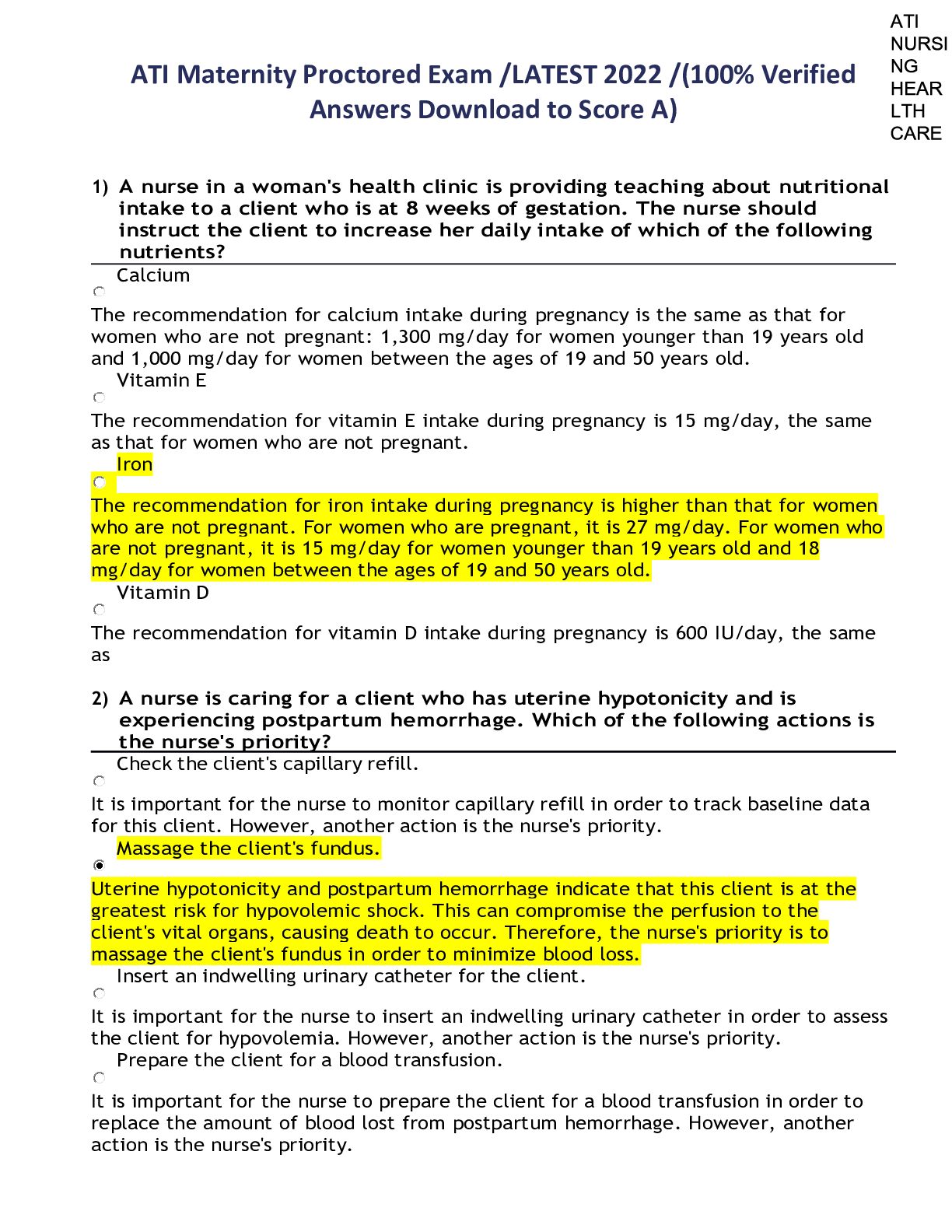Ati Teas Study Guide (QUESTIONS AND ANSWERS) | Download To Score An A.
Document Content and Description Below
Ati Teas Study Guide: Reading Section: Passages that you might have: King Henry VII- Expository ·0 The word infamous in the passage means – Notorious Social Media- Persuasive ·1 It’s... talking how now of days there’s a lot of news on the internet, which some are true and some are fakes. People just share them depends on how they feel about it. ·2 It’s trying to get people to fact checking before just posting random information. (By Tamika Y.) UFO- Narrative ·3 It’s talking about aliens, and an old man that got lost. (READ THE PASSAGE, Is on The GROUP :) Greek Theater- Expository The robbery passage (Dog and Humans are Best friend)- Persuasive ·4 When it asks how would you rename this passage answer is (Jewel Thief on the Lose) Frida Kahlo- Expository/ Informative ·5 They will ask you to put her life in chronological order and the answer to that question is: First, she got hit by a train; Next, she started drawing pictures of herself; Then, she married Diego. (Credit to Tamika Young for this) Casino Passage- Persuasive ·6 It’s trying to explain how is better to go to a Casino then buying a lottery ticket. Buying a lottery ticket, you have a lowest change of winning than going to a Casino and playing. The Chili Recipe- Expository ·7 Read carefully the Recipe and the questions. ·8 One of the answers is to rinse the beans first. Central Park Passage- Expository / Informative ·9 All I remember is that it’s a famous park in New York. ·10 The passage will ask you to put the sentences in chronological order. (By Tamika Y.) Time Management- Chimney Passage- Type of Passages: ·11 Expository: Something you find in an academic journal, a recipe, etc. (Very technical) (Teach, Inform, or explain.) ·12 Technical: Is like following steps to complete something. ·13 Narrative: Telling a story and entertain ·14 Persuasive: Making you believe something or to do something. ·15 Descriptive: Give physical details or provide unique characteristics Most know this: ·16 Author Purpose: His reason to write a specific topic. ·17 Theme: The subject to talk, a piece of writing, a person thoughts. ·18 Topic: that part of a sentence about which something is said. (a conversation) ·19 Main Idea: Is usually in the first sentence, overall idea of the paragraph. ·20 Fact: Something that it can be prove is true. ·21 Opinion: A view or judgment. ·22 Bia: Against something or someone. ·23 Compare: two or more ·24 Inform: Give facts ·25 Entertain: Fiction ·26 Express: Feelings ·27 Stereotypes: A characteristics ascribed to groups of people involving gender, race, origin, etc. ·28 Cause and Effect: The author describes a situation and then its effects. ·29 Compare and Contrast: The author explores the similarities and differences between two or more things. ·30 Chronological: The author list events in the order in which they happened. ·31 Mood: Influences a reader emotional state in the piece. ·32 Tone: Describes the author’s attitude toward the topic. To Respond to Questions, you Should know this: ·33 Almanac: A book that gives you important dates such tidal waves, astronomical events, etc. ·34 Thesaurus: A dictionary that has definitions, synonyms and antonyms. ·35 Bibliography: A list of books, magazines, articles, etc. ·36 Biography: Story of someone written by someone else. ·37 Autobiography: Story of someone written by the same person. ·38 Atlas: A book of maps or charts. ·39 Appendix: A section or table at the end of the book. ·40 Index: Reference in alphabetical order to where everything is in the book. ·41 Glossary: Alphabetical list of terms of words with definition. The word Disseminate is in one the Passages and they ask you what does it means: Answer will be (Spread of disperse) ·42 Metaphor: A figure of speech containing an implied comparison, in which a word or phrase ordinarily and primarily used of one thing is applied to another. Example: Noah Has a heart of a lion ·43 Simile: A comparison of two different things using the words LIKE or AS. Example: On her first day of school, Jane was as cool as a cucumber. ·44 Forum: Online message board. ·45 Rhetorical: Used for effect not meaning. ·46 Memorandum: A written informal note usually used for business purposes. ·47 Sequential: Following SET of Orders. (First, Second, Third, Next, While, Last, Before, After) ·48 Anecdote: A short story that illustrates a concept but isn’t the main idea. Math Section: Percentages (Very Important, Must Know): Covert Decimal to Percent by: Multiplying by 100 Convert Percent to Decimal by: Divide by 100 Convert Decimal to a Fraction by: Milli means: one thousand of something 1Liter (L) = 1000mL 1 Yard (Yd.) = 3 Feet (Ft) 12 Foot = 4Yd 1inch = 12 Ft Less than < Less or Equal than ≤ Greater than > Greater or Equal than ≥ Irrational Number: A number that can NOT Be expressed as terminating or repeating decimals. Rational Numbers: A number that can be expresses as a fraction. ·49 Example: 1/2 Contextual: Related to surrounding content. Erroneous: Incorrect Extraneous: Irrelevant Solution: The answer Terminate: To end Percent means: Per 100 Area of a circle: A=π × r^2 Area formula of a Square: A= L × L^2 Area of a rectangle: A= L × W Area of a triangle: A= ½ × b × h ALWAYS REMEMBER: King Henry Die By Drinking Chocolate Milk Example of a question that could be on the Test: What number is 20% of 8? ·50 You must multiply 20% × 8 = 160 ·51 160 divided by 100= 1.6 24 is what % of 250? ·52 24 divided by 250 = 0.096 ·53 Then multiply 0.096 times 100 to get the percent which = 9.6% 5/8 of my class passed. What percentage of students in my class failed? ·54 5 divided by 8 = 62.5 ·55 100 – 62.5= 37.5 didn’t passed, but you must convert this into a fraction ·56 The answer will be 3/8 Failed. When Solving an equation always use PENDAS: Practice Adding and Subtracting Fractions: Practice Multiplication and Division Fractions: Practice Absolute Value Problems: Percent Decrease: PD= Original amount – New Amount/ Original Amount × 100 Percent Increase: PI= New Amount – Original Amount/ New Amount × 100 Proportions: Problem that could be on the test: ·57 A store sells two kinds of candles, scented and unscented. The scented burn 1/12 inches in 20 mins. The unscented burns 1/16 inches in 30 mins. Which type of candle burns in 1 Hour and what is its burn rate? 60 Minutes = 1 Hour Scented Candle ·58 20 Minutes in an hour goes 3 Times (20+20+20=60) ·59 1/12 *3 = 3/12 – You got to simplify so it will be ¼ Unscented Candle ·60 30 Minutes in an hour goes 2 times (30+30=60) ·61 1/16 *2 = 2/16 – You got to simplify so it will be 1/8 The answer will be the scented candle burn in 1 hour and its burn rate is ¼ ·62 A worker is paid 2,350 monthly and has $468 withheld from each monthly paycheck. Which of the following is her annual salary? A. 27,732 B. 22,584 C. 28,200 D. 33,816 is Paid $2350 monthly - $468 withheld each monthly paycheck = $1882 * 12 month = $22584 Annual Salar You must know this because they will ask you to round decimals up. Example: There’s a question in the teas that in order for you to get it right you need to know the sides of the triangle: Must know how to identify this chart: Must arrange the number from least to greatest or greatest to least. Must know MEAN, MEDIAN, MODE and RANGE! SCIENCE SECTION: Cell Parts and their Functions Mitochondria- generate ATP Golgi Apparatus- package proteins Lysosomes- digest protein, carbs, and lipids. And gets rid of worn out particles Ribosomes- protein synthesis Nucleus- where DNA is located and tells cells their functions Peroxisomes- oxidation and detoxification What is found in Prokaryotes and Eukaryotes cells? - Cell Membrane/Plasma membrane, DNA, Ribosomes How does water move through the cell membranes? - Proteins Respiratory System What transport is gas exchange? Passive transport How does gas exchange occur? –Diffusion Where does gas exchange occur? –Alveoli What is the cause of emphysema? -chemical pollutants, smoke What is responsible for speech? –larynx What control the breathing process? - Medulla oblongata Cardiovascular System What carries oxygenated blood? –An artery moving blood from the heart to a muscle What is function of lymph nodes? - filter debris from intracellular spaces What is the function of the spleen? - Filter blood and help fight infections What is the most abundant cells? - Red blood cells What is the pacemaker of the heart? - Sinoatrial node What is the function of the circulatory system? –Transport hormones ***Know the blood flow of the heart*** Gastrointestinal System What are the digestive enzymes? – Pepsin, Mucus, Hydrochloric What neutralizes stomach acid? - Bile/Sodium bicarbonate What are gastrulation cells? - Germ cells Where is bile stored? - Gallbladder What produces bile? -Liver What does villi do? - Increase surface area absorption Enzyme lipase function? - Breakdown lipids Enzyme protease function? - Breakdown proteins Enzyme amylase function? - Breakdown carbs Where are nutrients absorbed? - Small intestine Where is water and vitamin k absorbed? – Large Intestine Neuromuscular System What happens if acetylcholinesterase is inhibited at the synapse? - Causes a muscle stimulation What is function of a neuron? - transmit information What is the function of myelin sheath? - Increase speed of electrical signals What causes goosebumps? - Arrector pili motor muscles/ sympathetic response What is function for actin and myosin? - Responsible for muscle movement What is function of a synapse? - Allow neurons to pass signals to neurons and muscles What is the sympathetic response responsible for? - Fight-or-flight What is the parasympathetic response responsible for? - Rest-and-Digest What makes up the central nervous system? - Brain and Spinal cord Cerebellum function? - Process and store information Medulla oblongata function? - Breathing Reproductive System Where is sperm produced? - Testes Where does fertilization occur? - Fallopian tubes What connects the cervix to the vagina? The vagina opening What is the function of the placenta? - Nourish fetus and remove waste Where are gametes produced? - Testes and Ovaries What stage is zygote in gestation? - First When is zygote formed? Is formed 22-26 hours after fertilization. What connects the ovaries and uterus? - Fallopian tubes Integumentary System What are the three skin layers? – Epidermis, Dermis, Hypodermis ·63 What are the epidermis layers? – “Come Let’s Get Sun Burned” (TOP to BOTTOM) • Stratum Corneum- all dead cells • Stratum Lucidum- dead cells in thick skin • Stratum Granulosum- mixture of old cells that are alive and dying cells • Stratum Spinosum- fairly young and happy cells • Stratum Basale- new healthy cells being produced (melanin is in this layer) What are sweat glands? - Eccrine glands, sudoriferous glands (stinky sweat) In which skin layer are sweat glands found? –Dermis What are oil glands? – Sebaceous (Sebum) Where skin layer are oil glands found? -Dermis What is the function of skin? – Thermoregulation/Homeostasis What is keratin? – Hair, nails What skin layer is keratin found? - Dermis Where is adipose/fat tissue located? - Hypodermis/Subcutaneous layer Which of the following are excreted through the skin? Urea, blood, and alcohol Endocrine System What organ needs iodine? - Thyroid Which gland shrinks with age? - Thymus What regulates sleep? – Pineal What secretes melatonin? Pineal What secretes insulin? - Pancreas What secretes alpha and beta cells? - Pancreas What are alpha cells? Glucagon What are beta cells? - Insulin What is the master gland? - Pituitary Pituitary- FSH, TSH, GH Hypothalamus- ADH, Oxytocin ***KNOW ALL HORMONES AND WHAT THEY SECRETE*** Genitourinary System What is the functional unit of the kidney? - Nephron What is the function of the kidney? - filter blood, create urine, and stabilize water What are kidney two major regions? – Cortex and medulla What regulated blood pressure? - Renin What transports sperm? – Vas Deferens and Urethra Immune System Active immunity- Vaccination Passive Immunity- Breastfeeding Where are blood cells produced? - Bone Marrow What does an increase in white blood cells mean? - Infection Macrophages? - respond to foreign substances T Lymphocytes- attacks viruses B Lymphocytes- SPECIFIC Bacteria Skeletal System What is osteoporosis? - brittle fragile bones What causes osteoporosis? Osteoclast and osteoblast (google which does what in osteoporosis) What is osteoblast? -Build bone What is osteoclast? - remove bone What is a long bone? – Femur, tibia What is a short bone? - Tarsals, What is a flat bone? - Skull ***KNOW THE BONE HEALING FORMATION STEPS (just google the image) A Few QUESTIONS: Which of the following blood vessels would contain highly oxygenated blood? ·64 Pulmonary Veins. When does the nuclear division of somatic cells take place during cellular reproduction? ·65 Mitosis Which organ gets rid of metabolic waste? ·66 Kidney What are the pores in the nuclear envelope used for? ·67 Regulate import and export of material between the nucleus and cytoplasm. Where does fertilization begin? ·68 In the end of the fallopian tubes away from the uterus close to the ovaries. What gland produces TSH? ·69 Pituitary gland. What are the 2 major parts of the nervous system? ·70 CNS/PNS What produces bile? ·71 Liver, store in gallbladder. Remember: A goes with T and G goes with C. What’s the job or amylase and lipase? ·72 Amylase helps your body break down starch. ·73 Lipase helps your body digest fats. Where does gas exchange occurs? ·74 It occurs in the lungs between the alveoli and a network of tiny blood vessels called capillaries. What is the function of the spleen? ·75 The spleen plays multiple supporting roles in the body. It acts as a filter for blood as part of the immune system. Old red blood cells are recycled in the spleen, and platelets and white blood cells are stored there. The spleen also helps fight certain kinds of bacteria that cause pneumonia and meningitis. What controls the breathing process? ·76 Diaphragm. What it’s the function of villi in the small intestine? ·77 they help with nutrient absorption. What gland produces melatonin? ·78 Pineal gland. Compare prokaryotic and eukaryotic cells? ·79 Prokaryotic cells DO NOT contain organelles, eukaryotic cells DO. Which of the following membranes protects the brain and the spinal cord? ·80 Meninges. The center of an atom is nucleus. What is the nucleus composed of? ·81 Protons and Electrons. Osteoporosis result from what? ·82 A decline of osteoblast activity while osteoclast activity continues at expected levels. What is the only artery in the body to carry oxygen poor blood? ·83 Pulmonary artery. Which of the following immunoglobin is found in a mother’s breast milk? ·84 lgA What are the smallest arteries called? ·85 Arterioles During the Krebs cycle of cellular respiration, glucose molecules are consumed. For every single consumed glucose molecule, what is produced? ·86 2ATP, 6 Carbon and 6NADH. Where is the sebaceous gland located? What is the longest phase of the cell cycle? ·87 Interphase. Kidneys remove which of the following from the blood? ·88 Salts. What is the first stage of gestation? ·89 Zygote What do plasma cells secrete? ·90 Antibiotics. The myocardium is the layer of the heart that contains? ·91 Smooth muscles. Where are water and vitamin stored? ·92 Large Intestine. ENGLISH SECTION: ·93 What is “singing” in the sentence: Singing is my favorite thing to do. ·94 A gerund, or verb that acts as a noun. ·95 Synonym of Necessitate: Entail, involve, require, demands, warrants. ·96 Is “Measles” singular? ·97 Yes. ·98 What is the meaning of disseminate? To disperse and spread out. ·99 What is the plural of crisis? Crises. ·100 What is the proper spelling below? Reccommendation Rekomendation Recommendation Recommendation ·101 Which of the following sentences correctly uses subject verb agreement? Computers has made our jobs easier. Those two girls in the first row is best friends. The dogs in our backyard growls late at night. The tennis balls rolls into the parking lot. Homograph: words that are spelled the same but have different meanings and origins. Homophone: words pronounced alike but with different meaning. Colon: used to introduce a list or quote, ratio, and time. Comma: before “and” in a simple series of items. Affix: letters added to the beginning or ending of a word to change its meaning. Prefix: an affix that’s added in front of a word. Suffix: an affix that appears at the end of the word. Derivation: determining the origin of a word. Inflection: details of how a word is expressed to modify its tone or meaning. Morpheme: the smallest unit in grammar. Root: a word to which an affix can be attached. Simple Subject: the main word or word group that tells whom or what the sentence is about. Simple predicate: the verb. Complete predicate: consists of a verb and all the words that describe the verb and complete its meaning. Direct object: the object that receives the direct action of the verb. Prepositional modifier: what does it feels. Diction: a writer’s or speaker’s choice of words. Fragment: an incomplete sentence; a break in a sentence. Perfective: a verb for an object that has been completed Prescriptive grammar: set of grammatical rules prescribed by a language authority. Progressive: a verb that shows something happening. Tense: past, present or future. Transition word: words that link or introduce ideas. Subject verb agreement: plural subjects must have a plural verb. Singular subject must have a singular verb. Pronoun antecedent agreement: pronouns and antecedents must agree in number and gender. Colloquialism: the use of informal words, phrases or even slang in a piece of writing. First person: uses the subject pronoun “I”. Second person: uses the subject pronoun “YOU”. Third person: uses the subject pronoun “He, She, and They”. Adverb: a word that modifies a verb, an adjective, or another adverb. Article: words (a and an) that refers to nouns. Complement: sentence part that gives more information about a subject or object. Conjunction: a word that joins two phrases or sentences. Independent clause: a group of words that contains a subject and a verb and expresses a complete thought. Dependent clause: a phrase that can’t stand alone as complete sentence. Indirect object: the person or thing to whom or which something is done. Interjection: a word that expresses emotion. Modifier: a word, phrase, or clause that qualifies or describes another word, phrase, or clause. Object: a word or phrase that receives the action of a verb. Predicate: tells something about the subject. Preposition: a word that shows the relationship of a noun or pronoun to another word. Pronoun: a word that takes place of a noun. Subject: the main noun or pronoun that tells what’s the sentence about. Simple Sentence: a sentence that is made up only by one independent clause. Complex Sentence: is made up with at least one independent clause and one dependent clause. Compound Complex Sentence: it contains two or more independent clauses and one independent clause. Adjective: a word that describes a noun. Clause: a group of words that contains a subject and a verb. Preposition: a word used to show the relation of a noun or pronoun to some other word in the sentence. Active voice: Herman wrote the paper. Passive voice: The paper was written by Herman. Context clues: clues in surrounding text that help the reader determine the meaning of an unknown word. Primary source: first-hand account of the event that was created at about the time the event occurred. Theories, opinions or actions, documents, recording. Secondary source: created by a person who did not witness the event. Prediction: discussing a future event or something that can be explicitly verified within the “natural course of things”. Inference: a guess based on clues. Conclusion: the end or finish of an event or process. Fact: a piece of information that can be proven. Opinion: a belief or judgement. Biases: prejudices or inclinations. Stereotype: a generalized belief about a group of people. Bibliophile: book lover. Alter: to change. Altar: place of sacrifice. Clichés: trite or overused expressions (When life gives you lemon, make lemonade. Slang: informal language. Synonym: words that mean the same thing. Antonyms: words that mean the opposite of another one. Compound noun: a single noun made up of two or more words used togethers. Example: mothers-in-law. Verb Example: run Adverb example: fast What’s the prefix of? Micro: small Macro: large Neo: new Sub: below, under Inter: between, among Ful: characterized by [Show More]
Last updated: 1 year ago
Preview 1 out of 29 pages
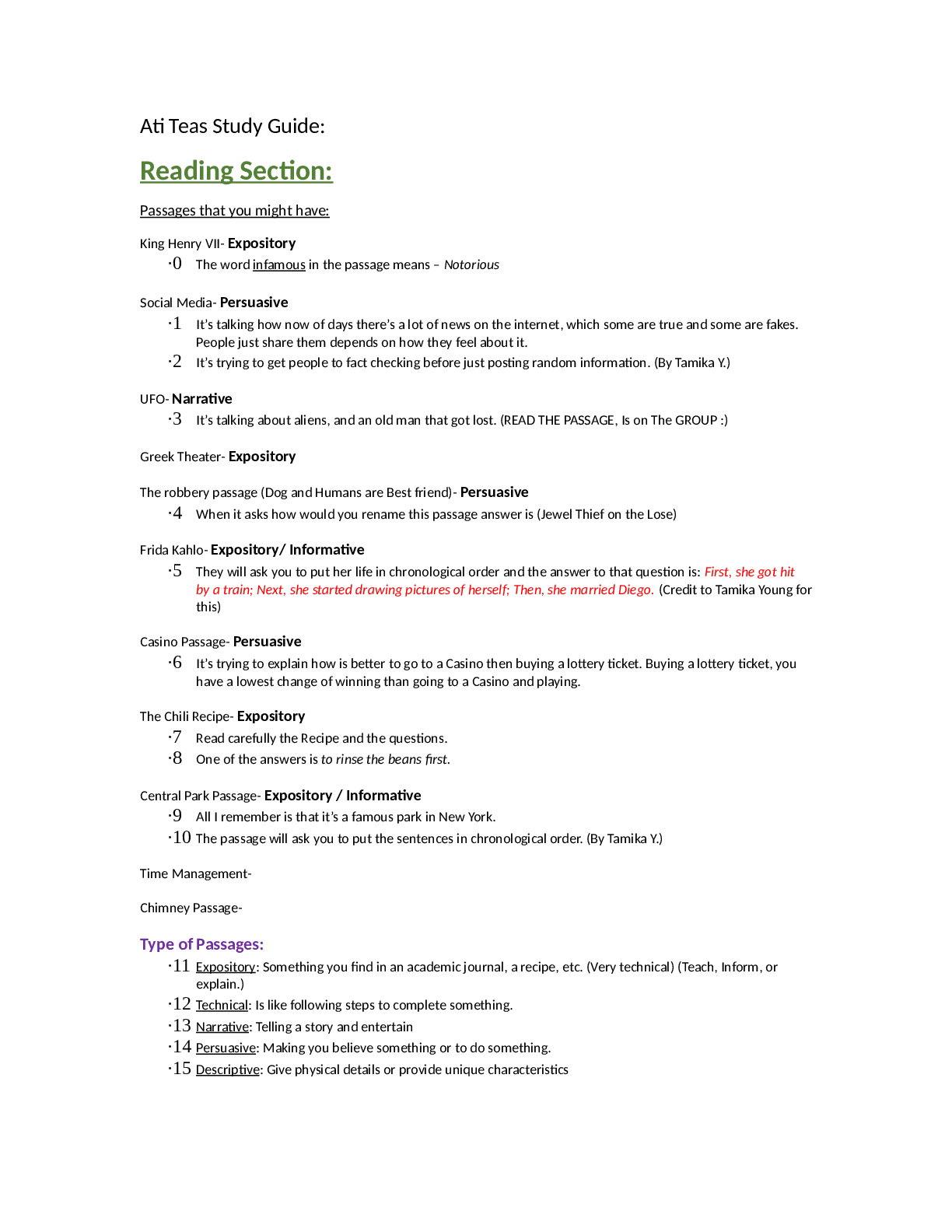
Reviews( 0 )
Document information
Connected school, study & course
About the document
Uploaded On
Oct 23, 2021
Number of pages
29
Written in
Additional information
This document has been written for:
Uploaded
Oct 23, 2021
Downloads
0
Views
136

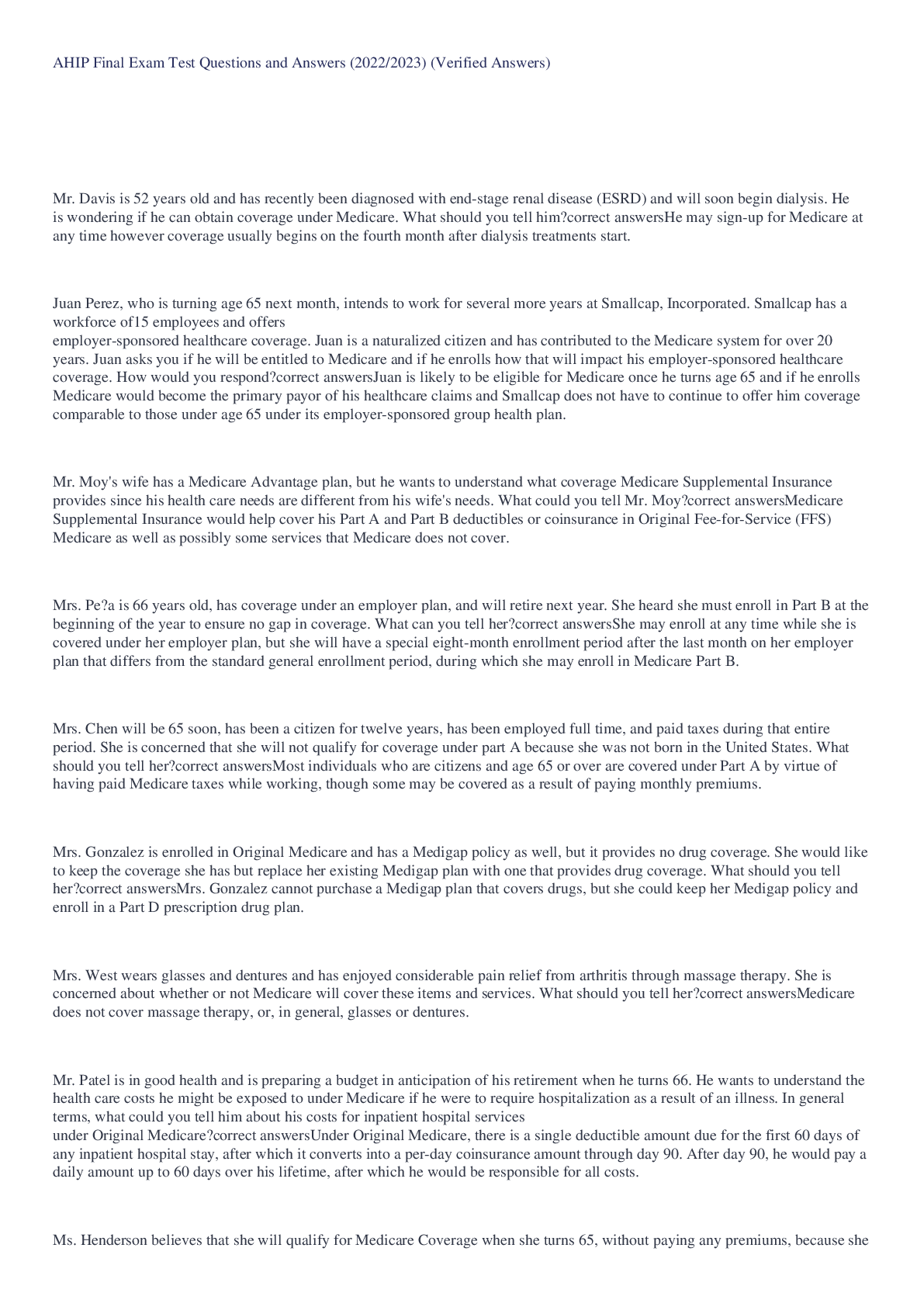

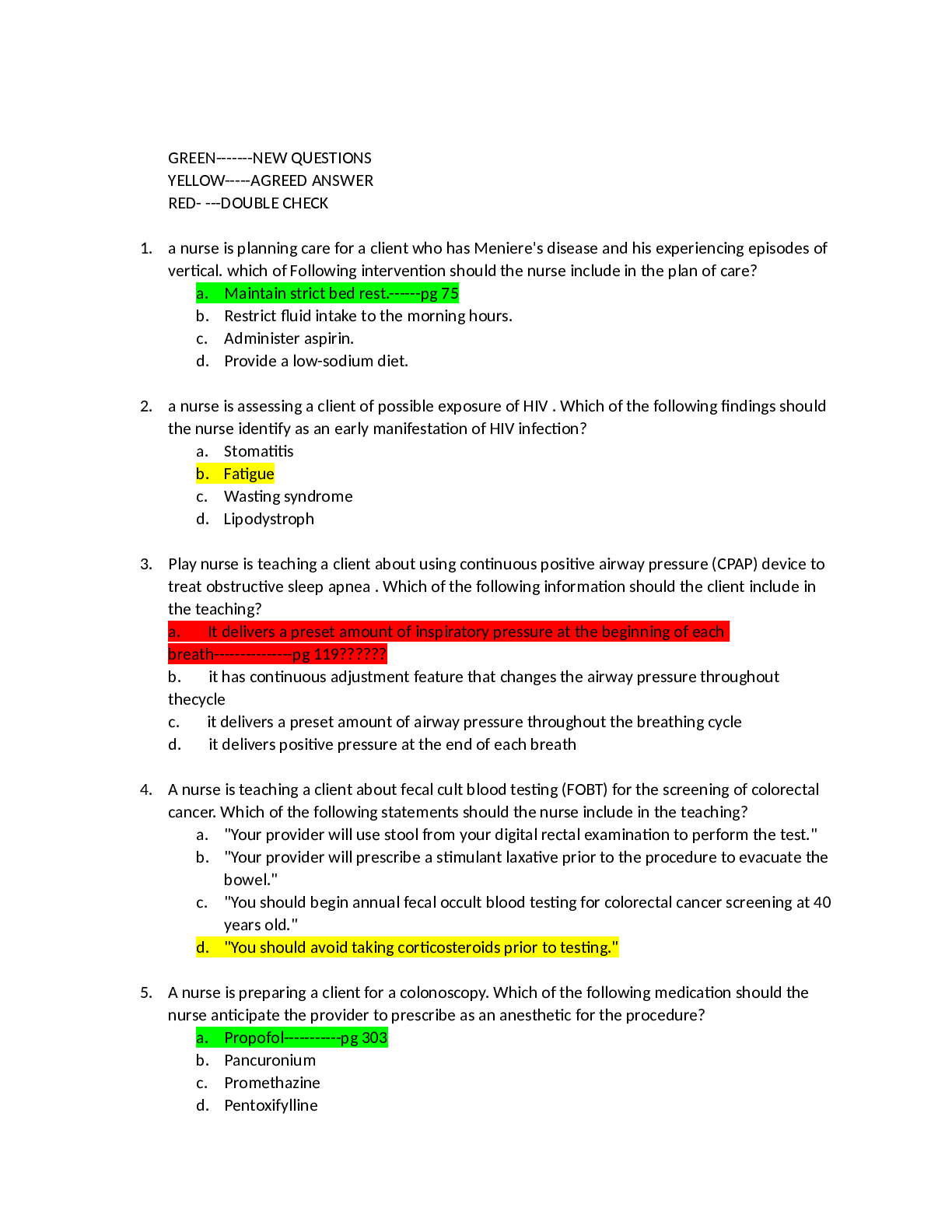
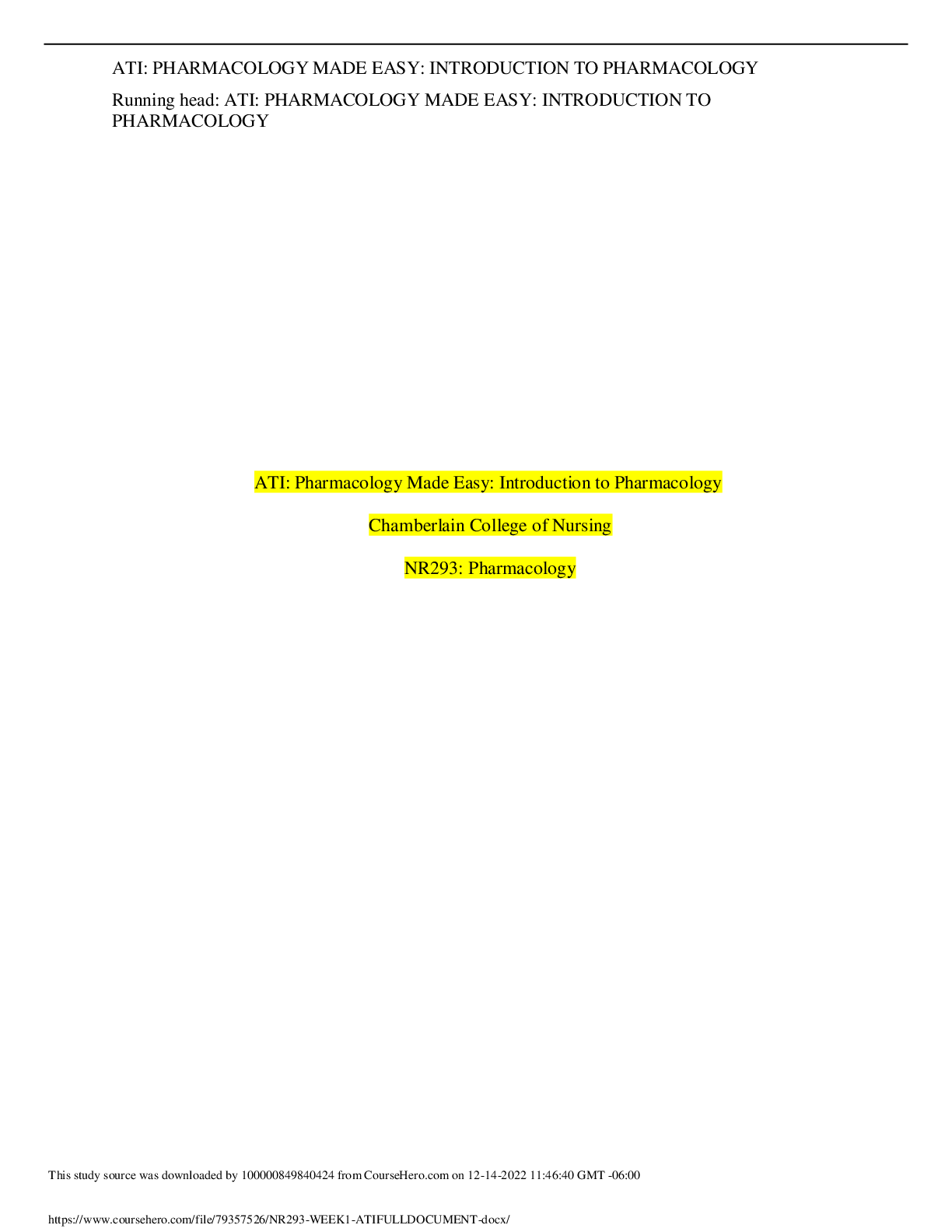
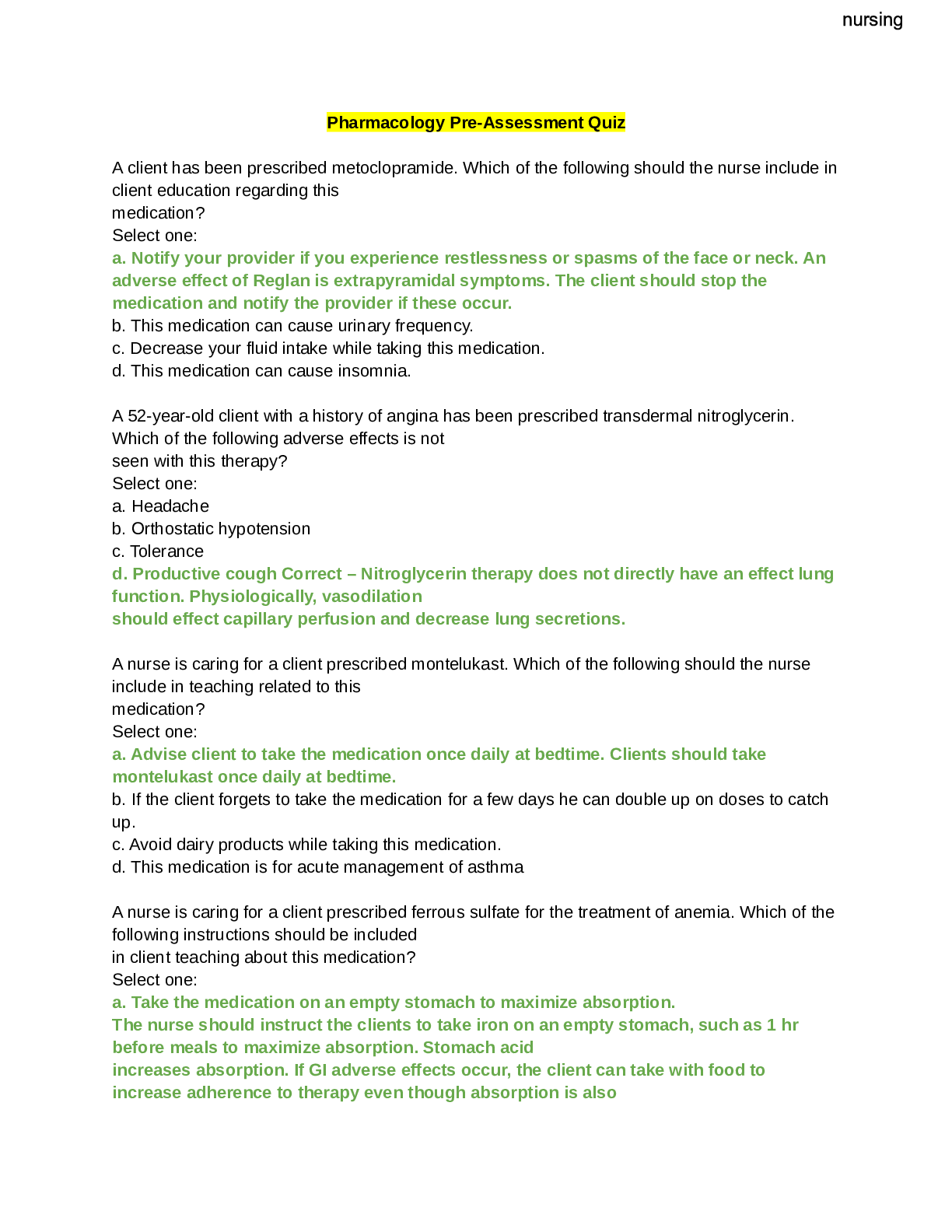
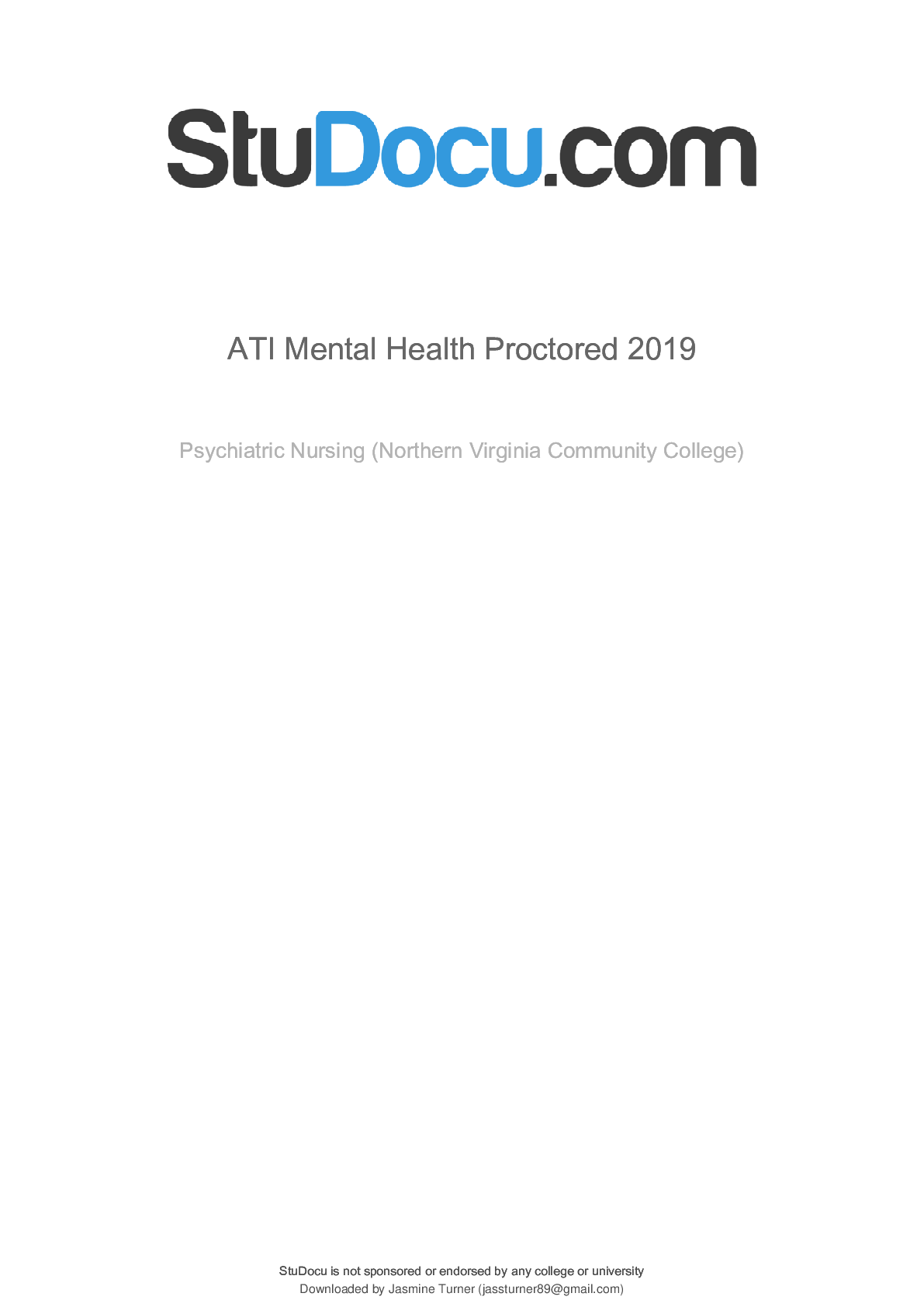
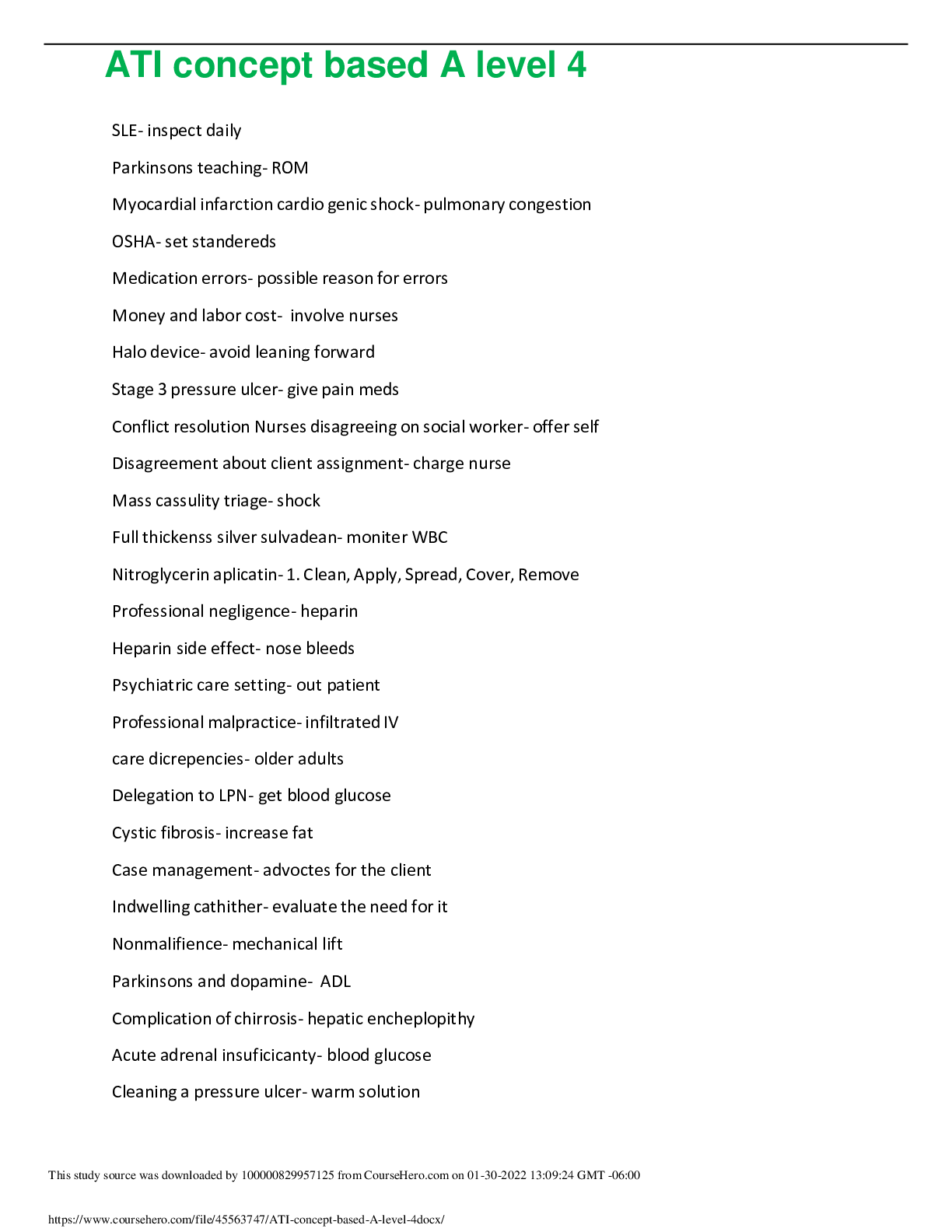
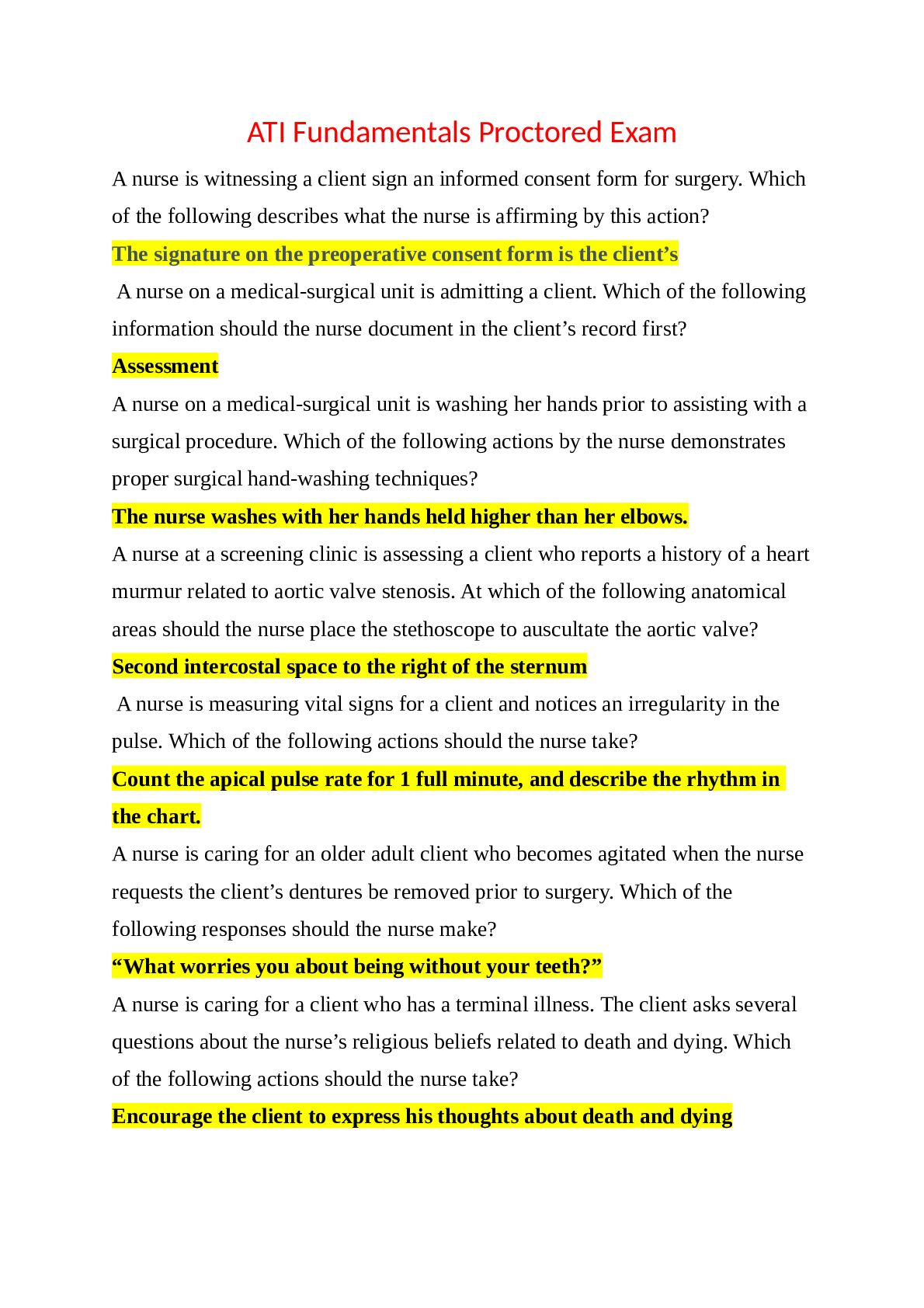
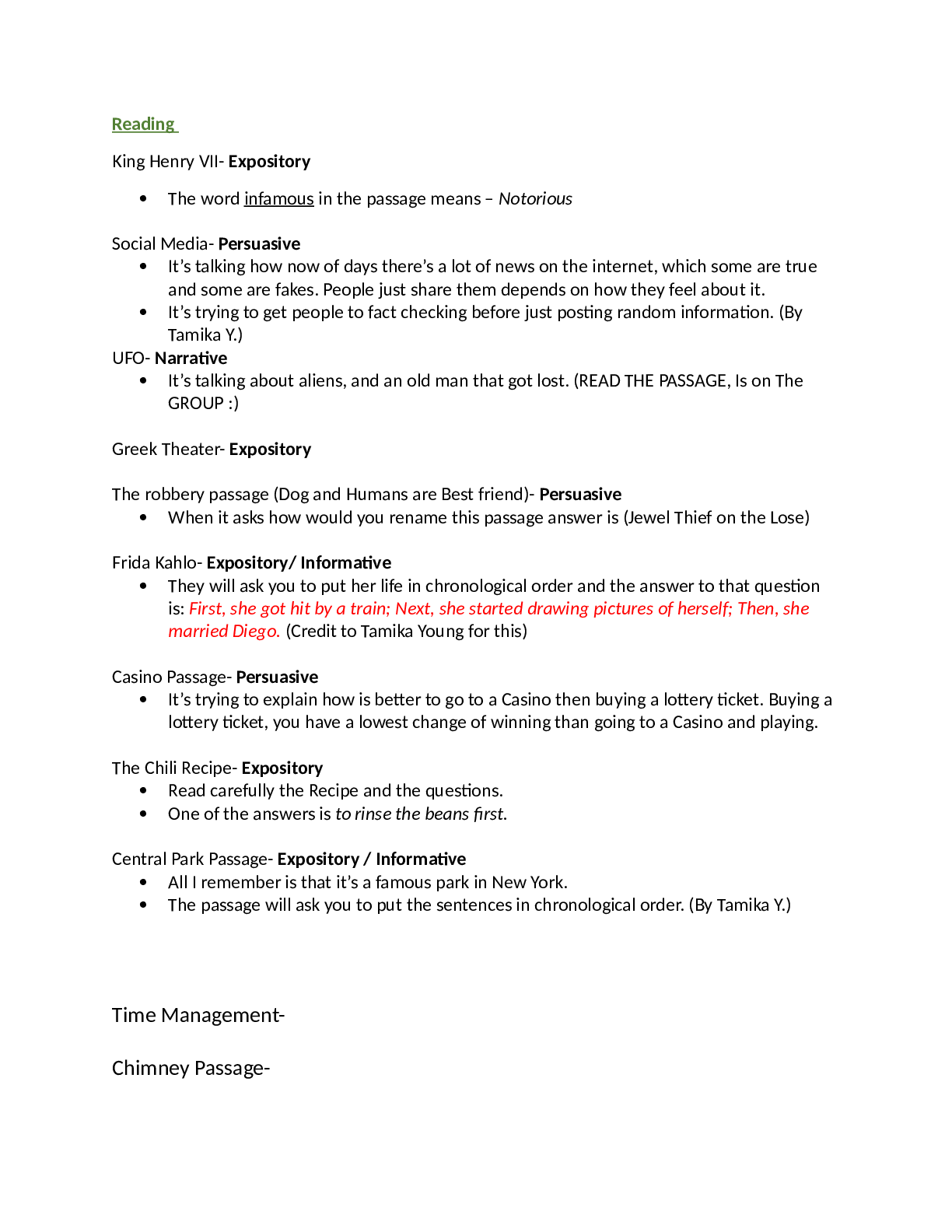
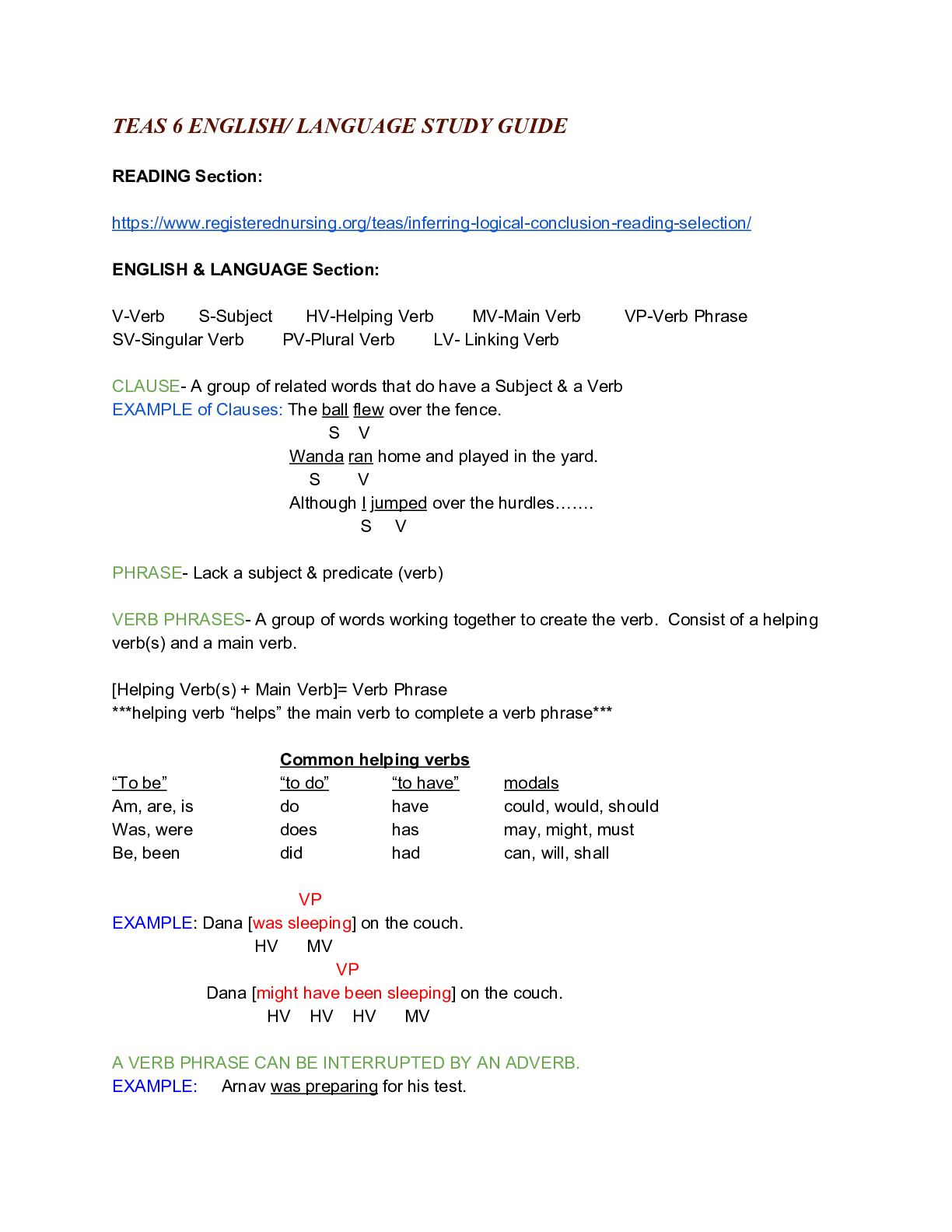
.png)
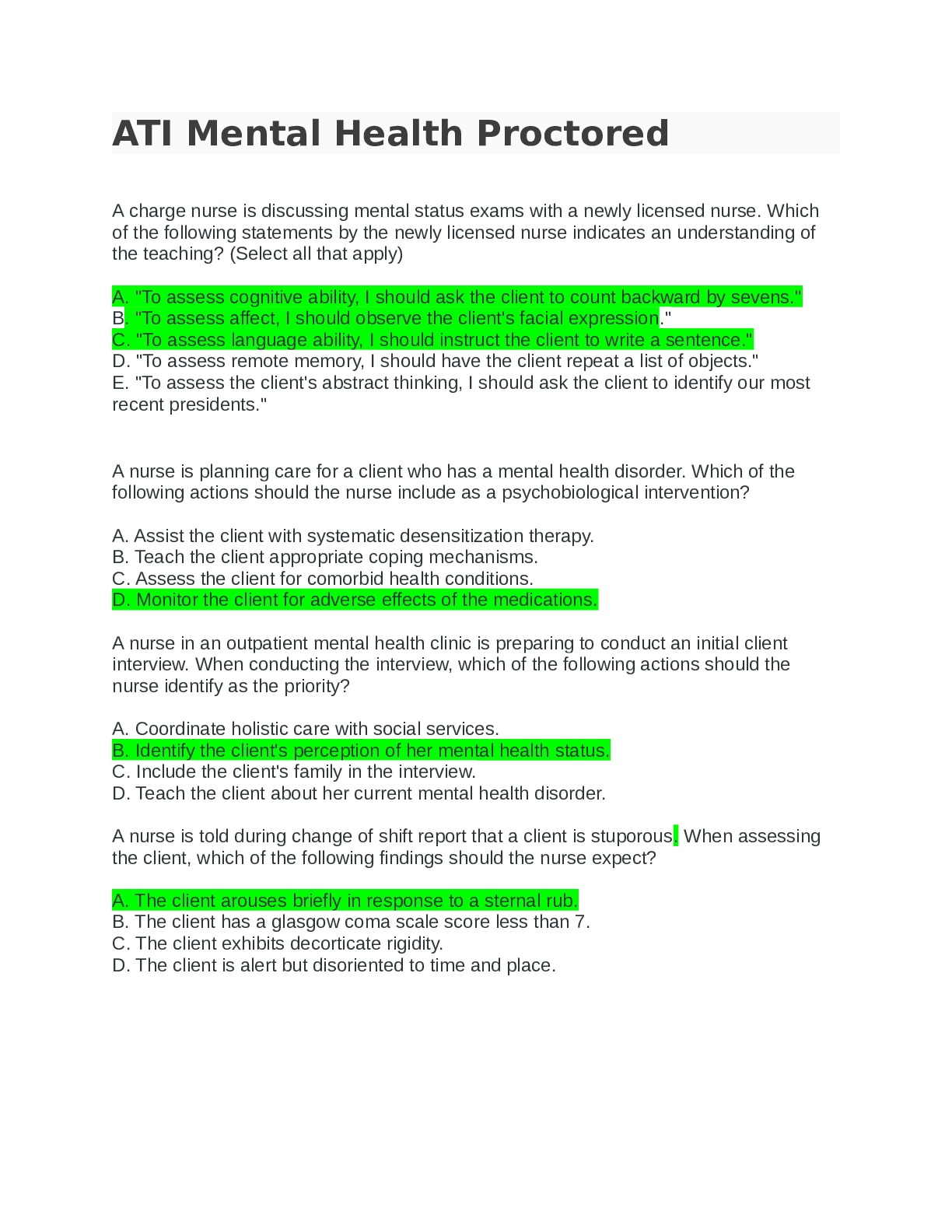
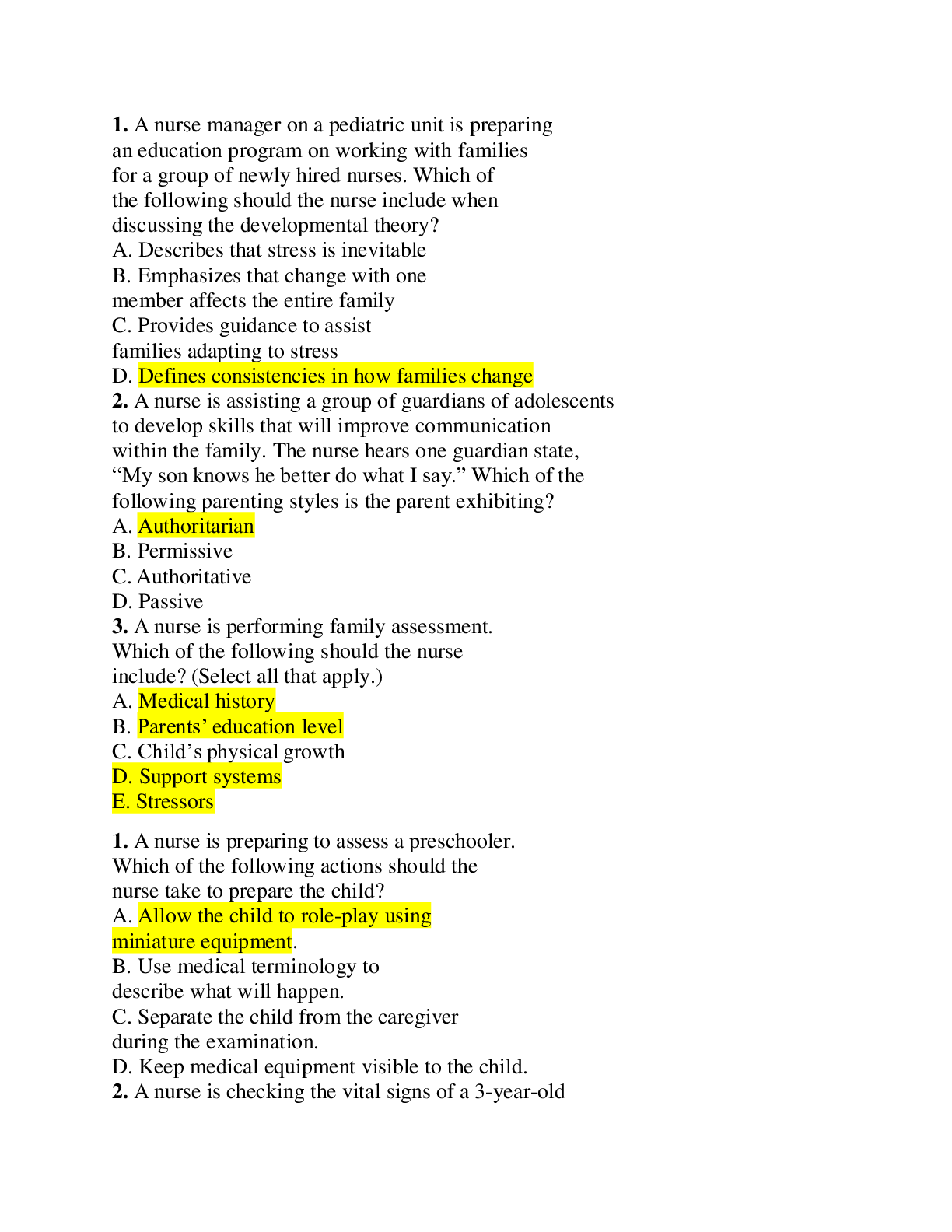
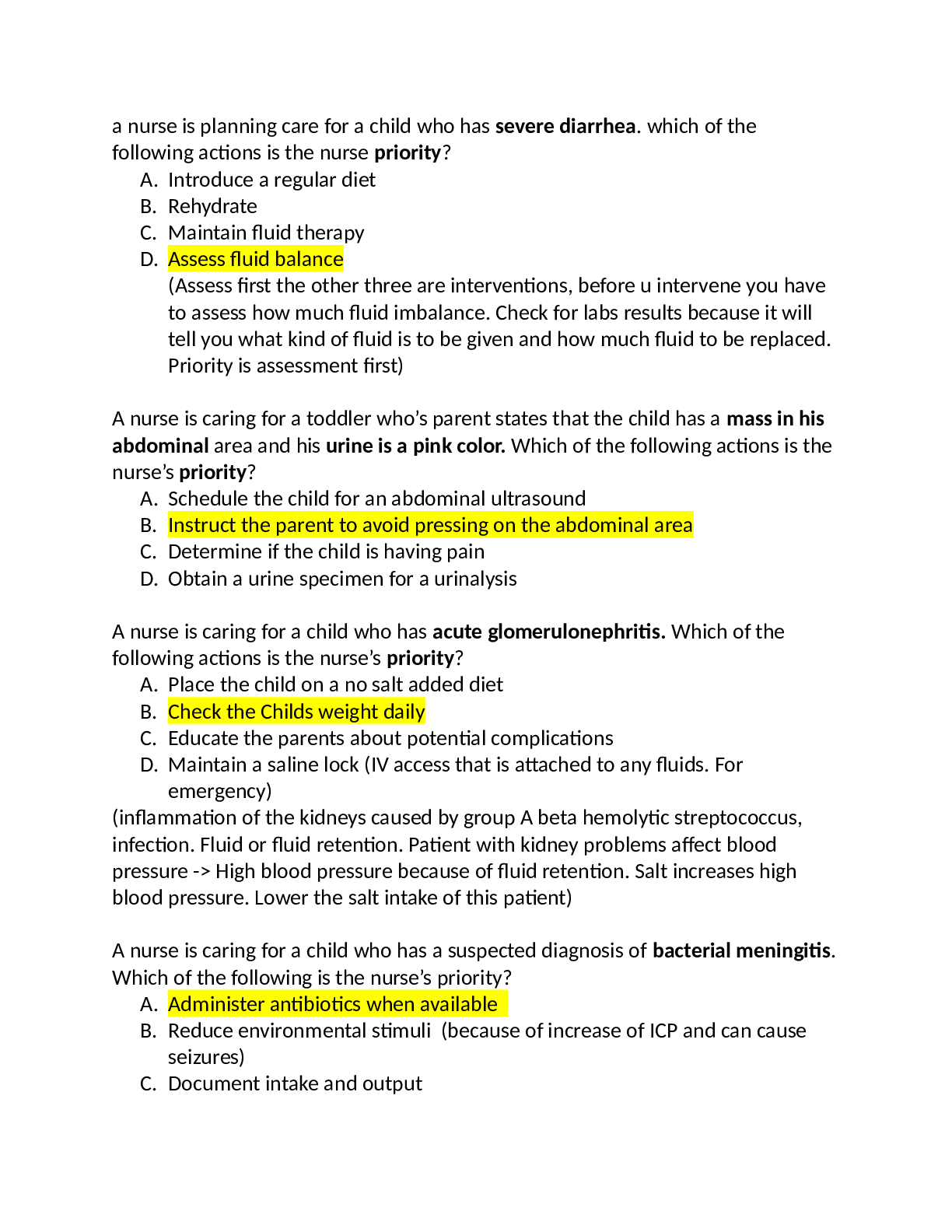
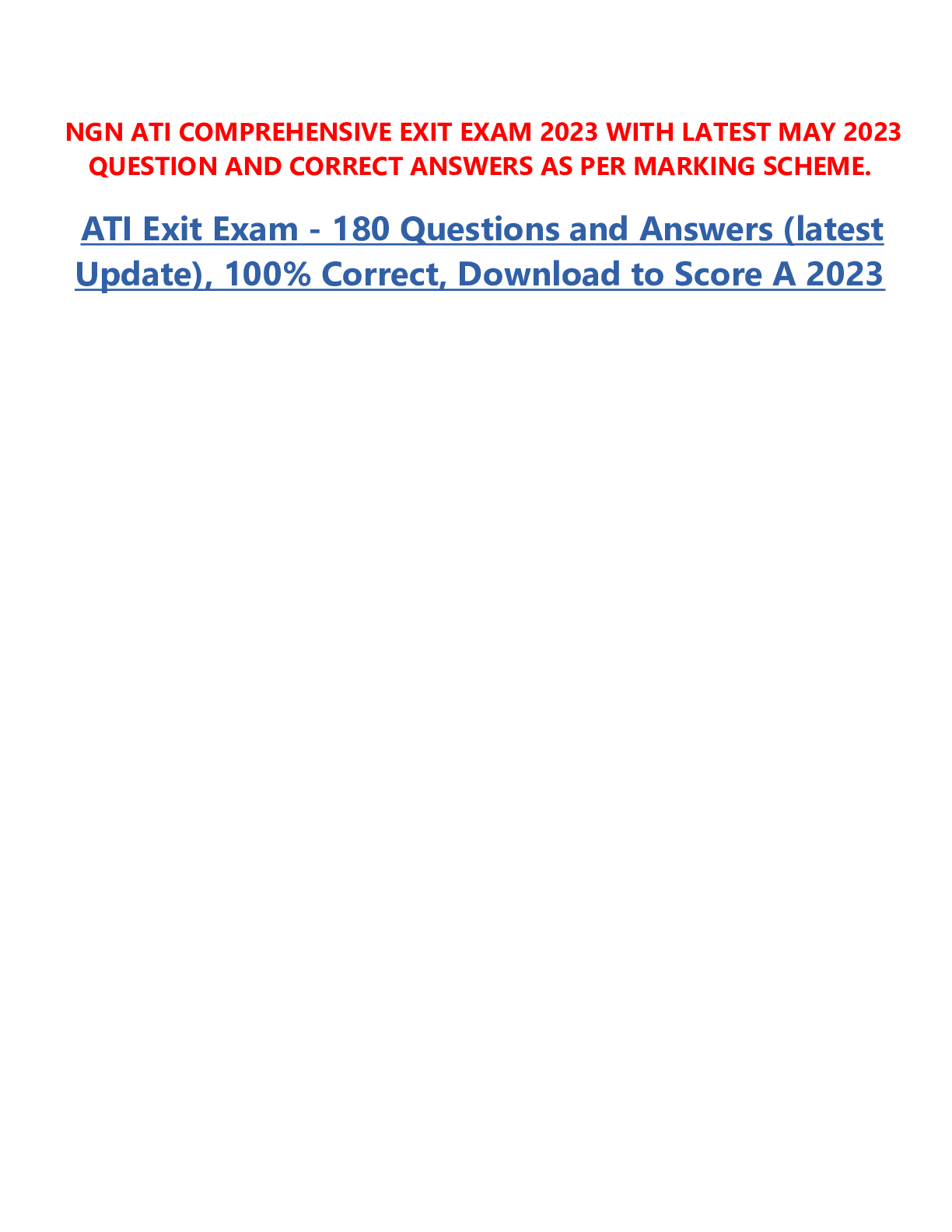
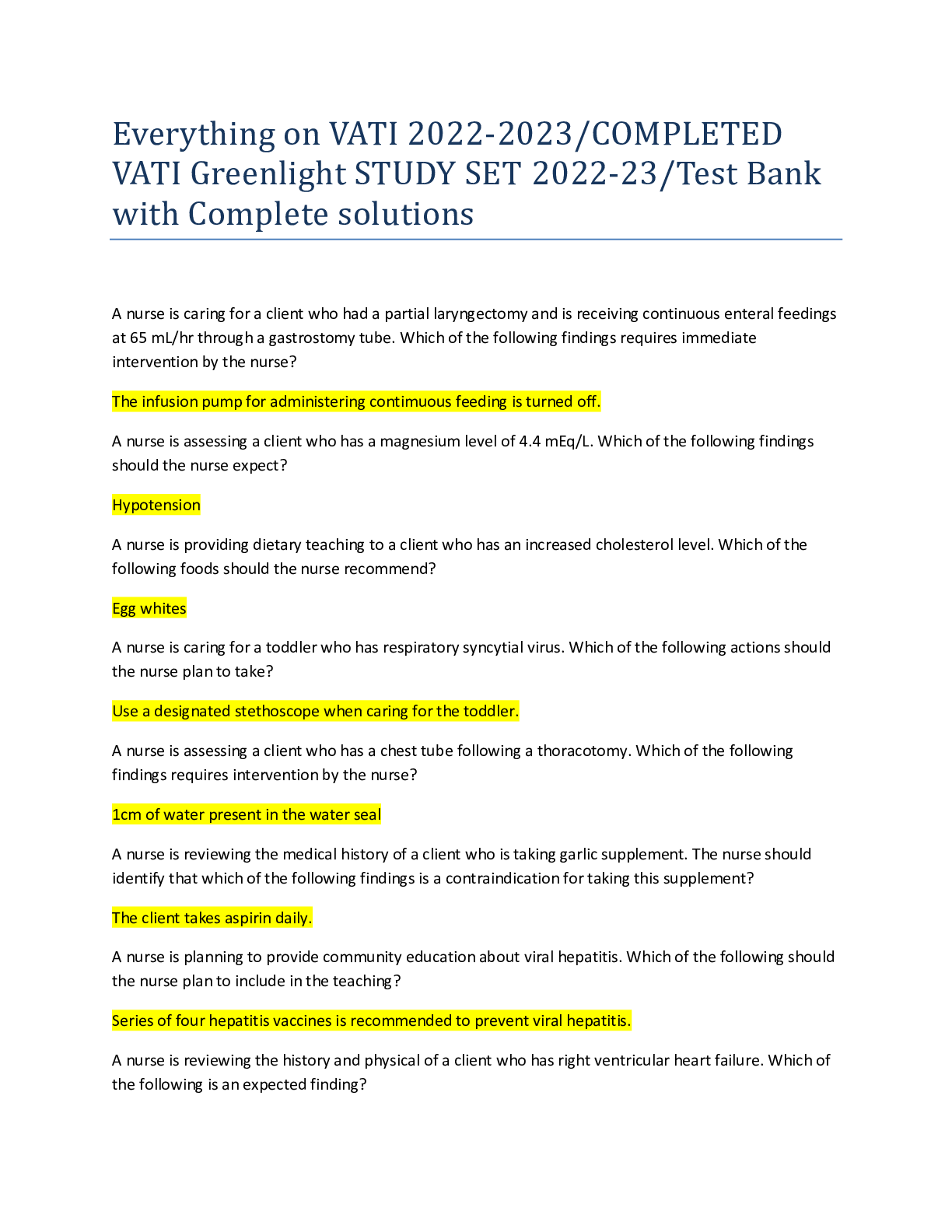
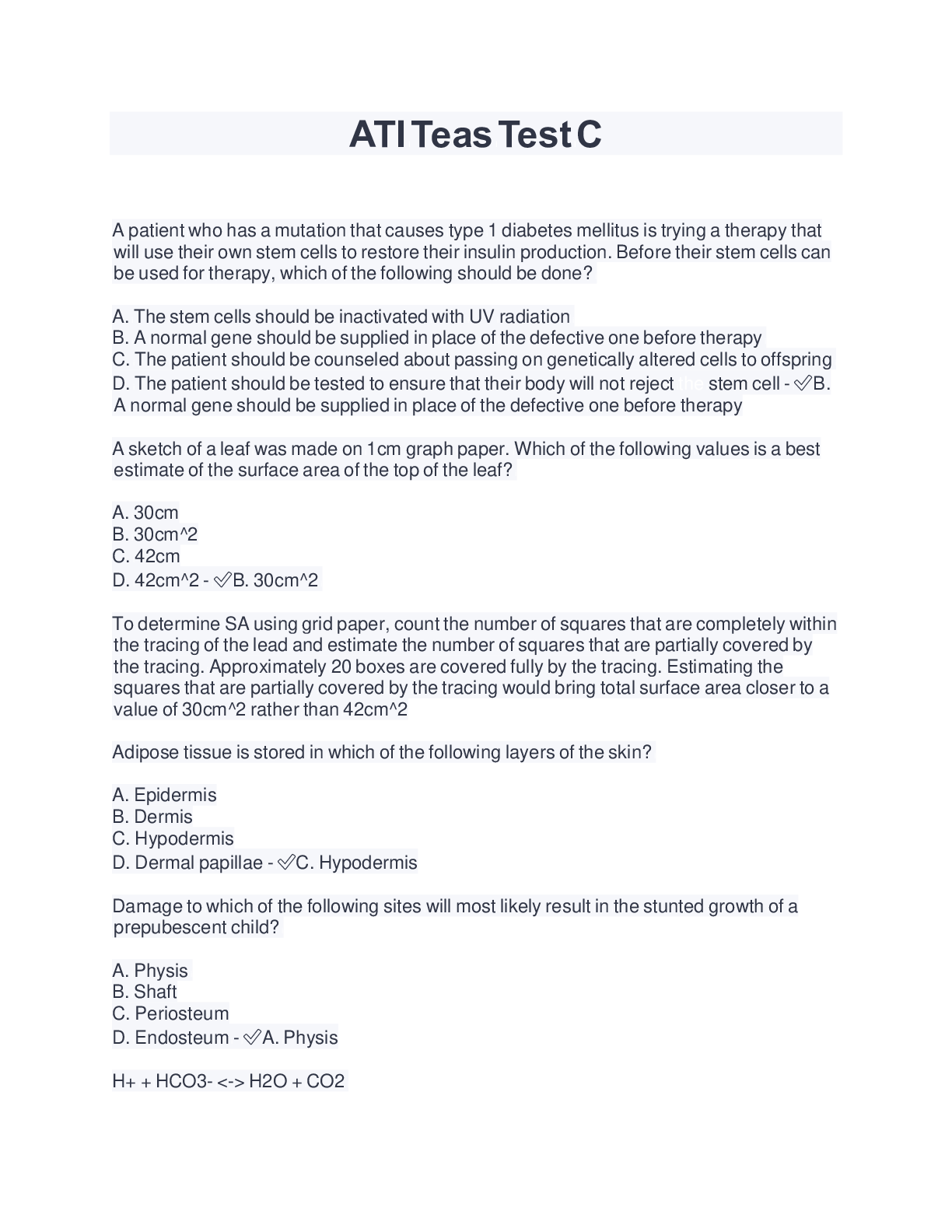
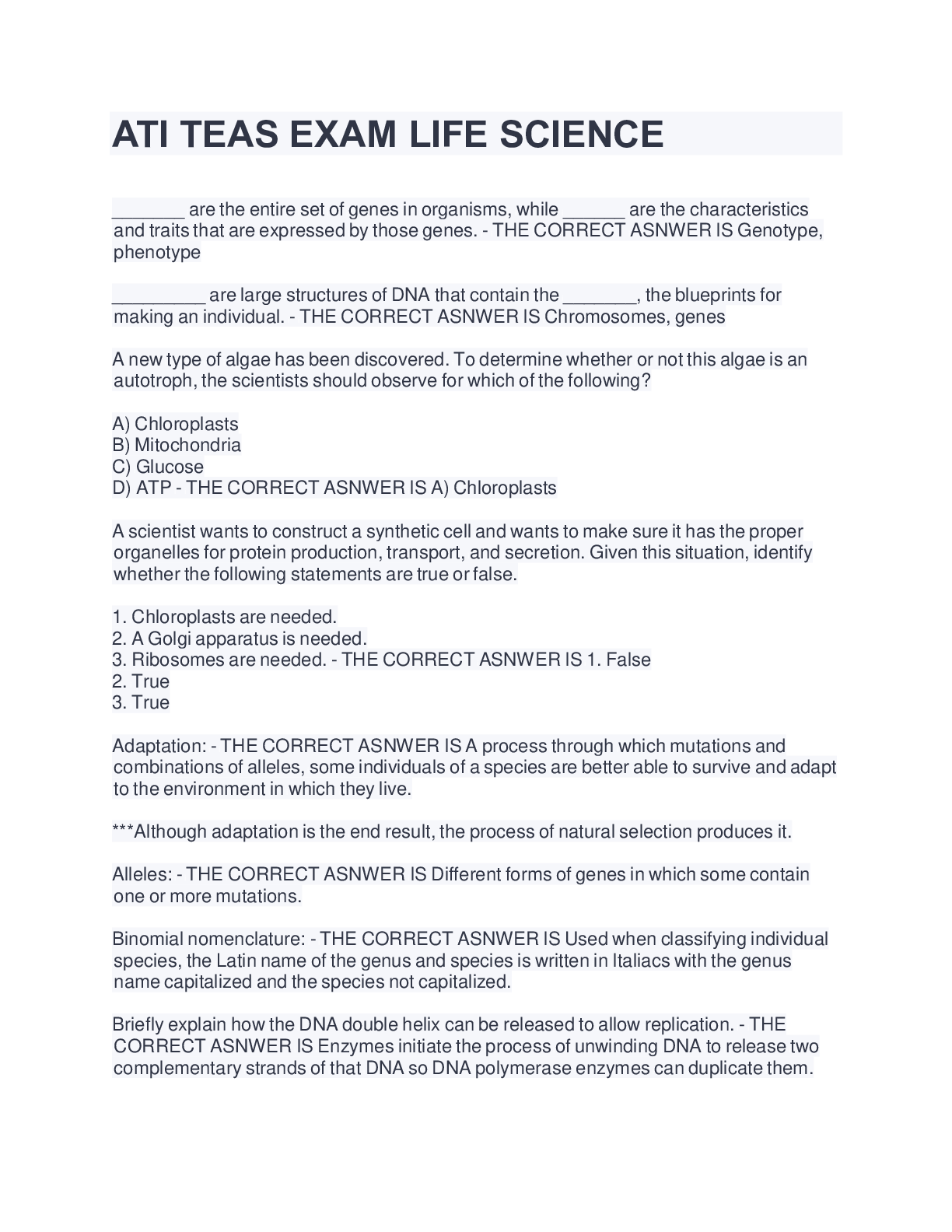
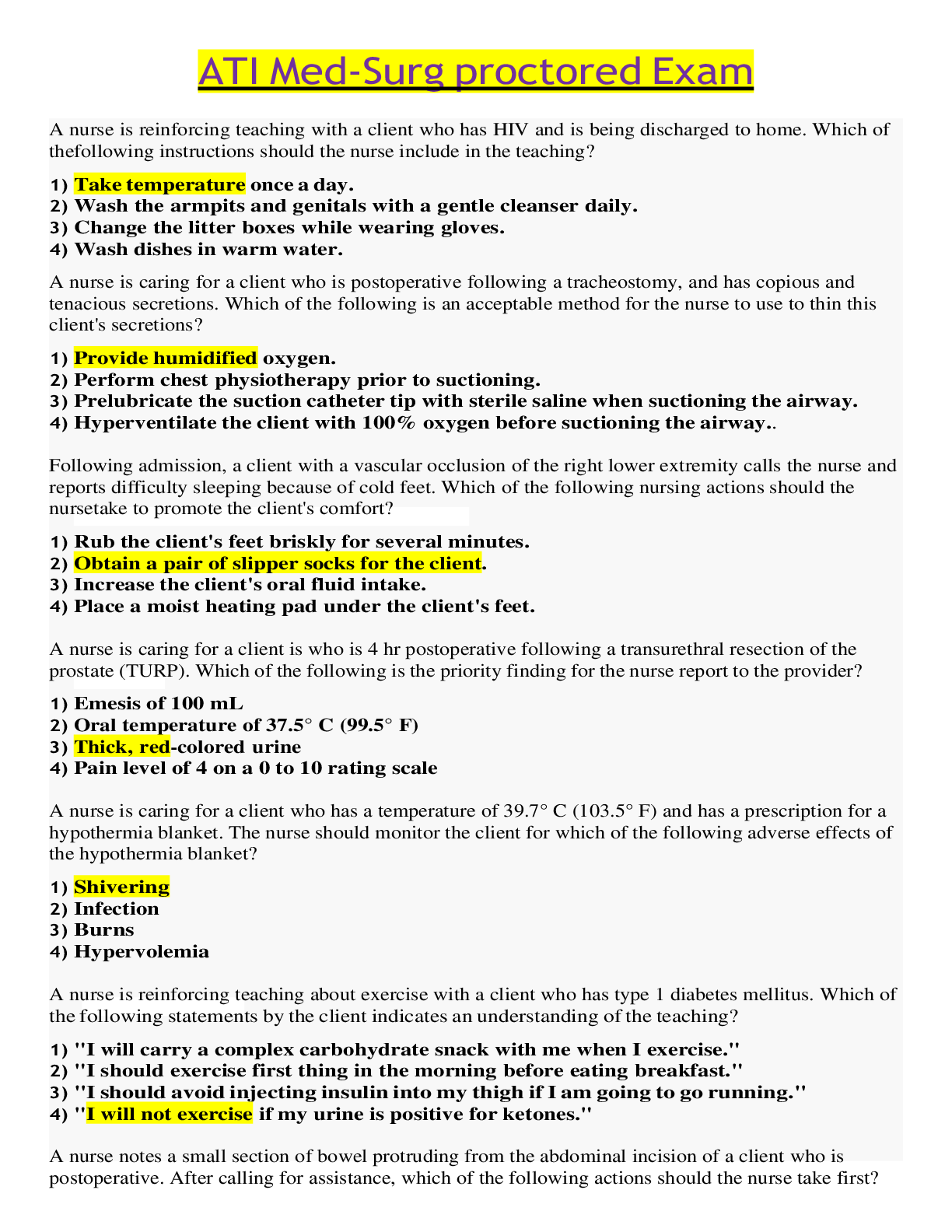
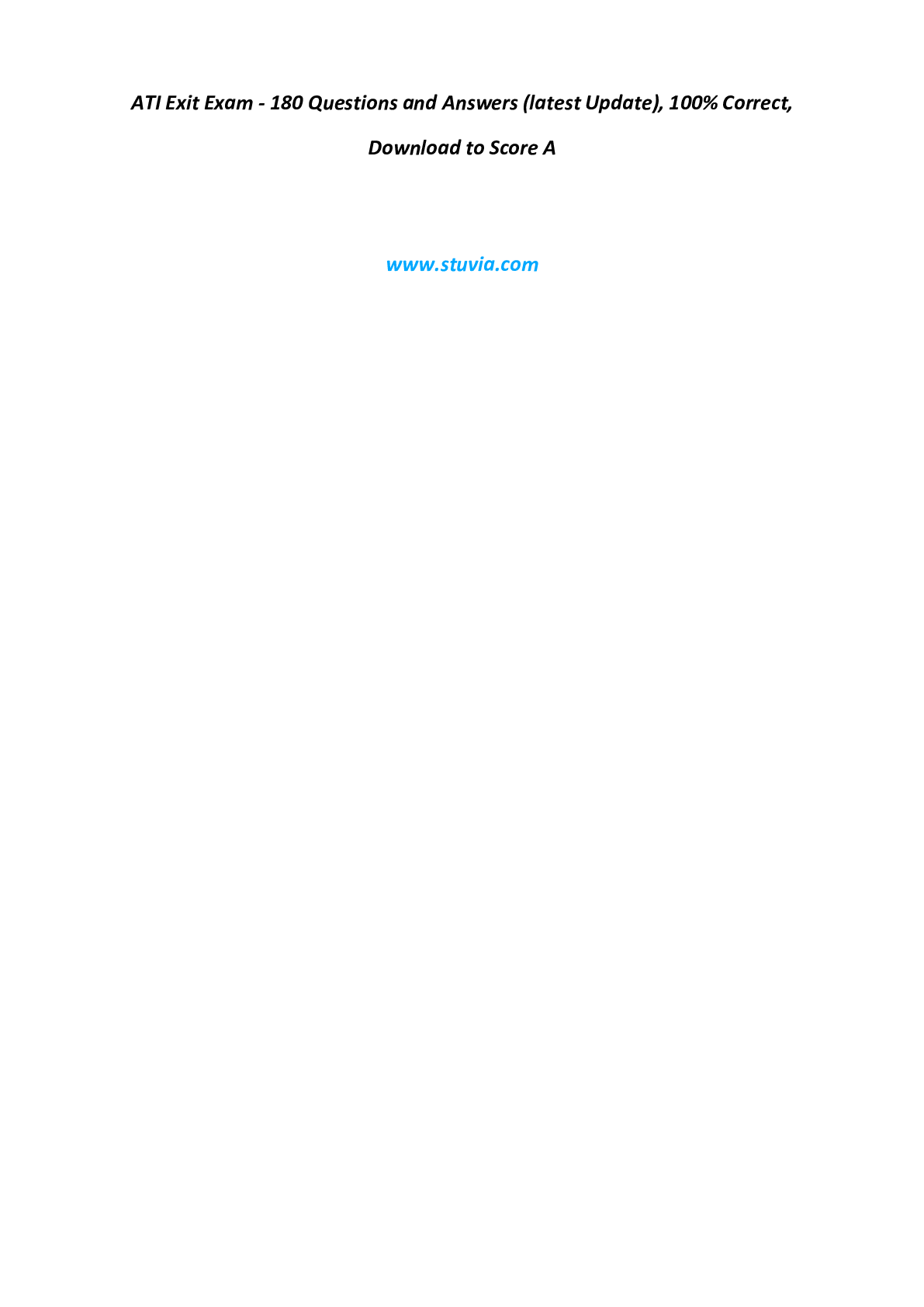
.png)
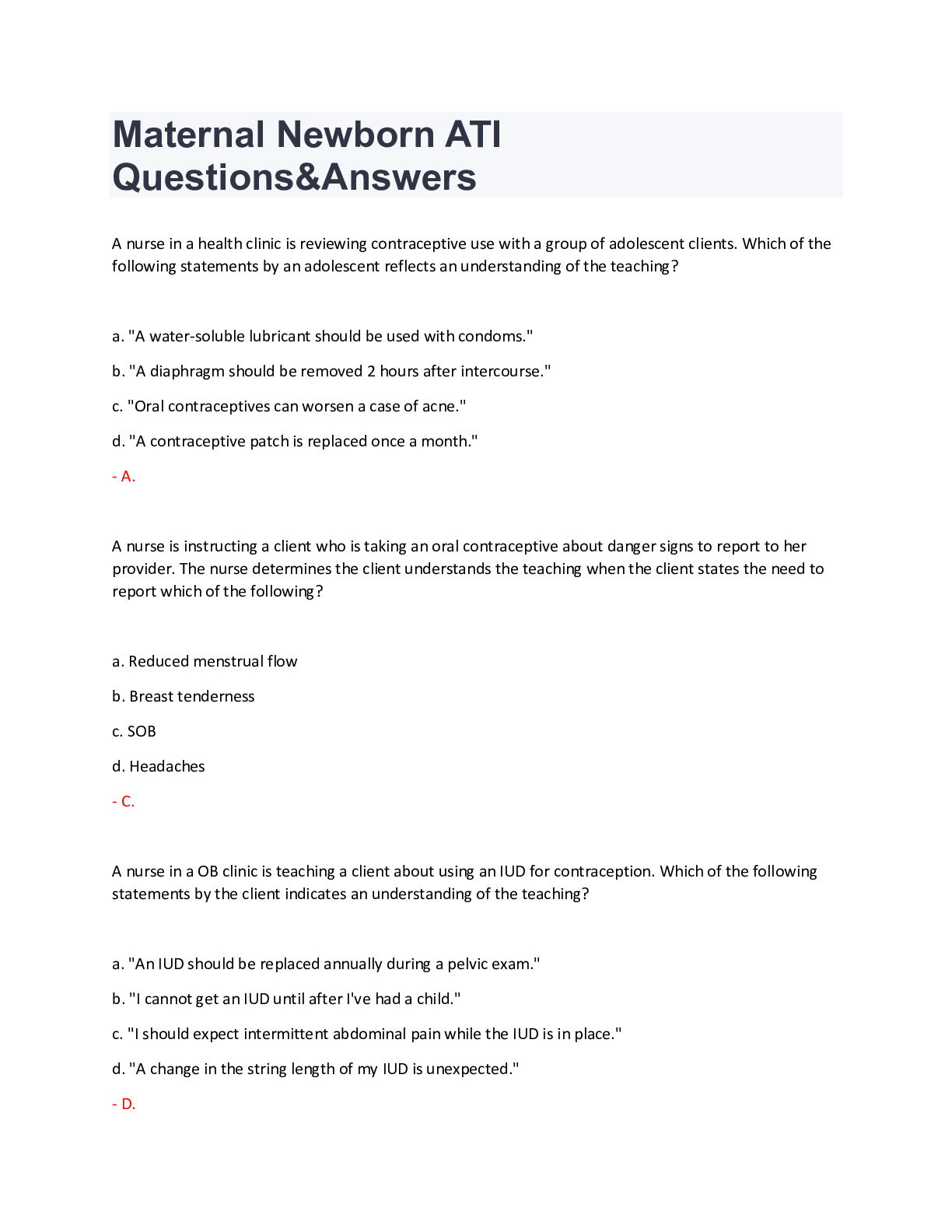
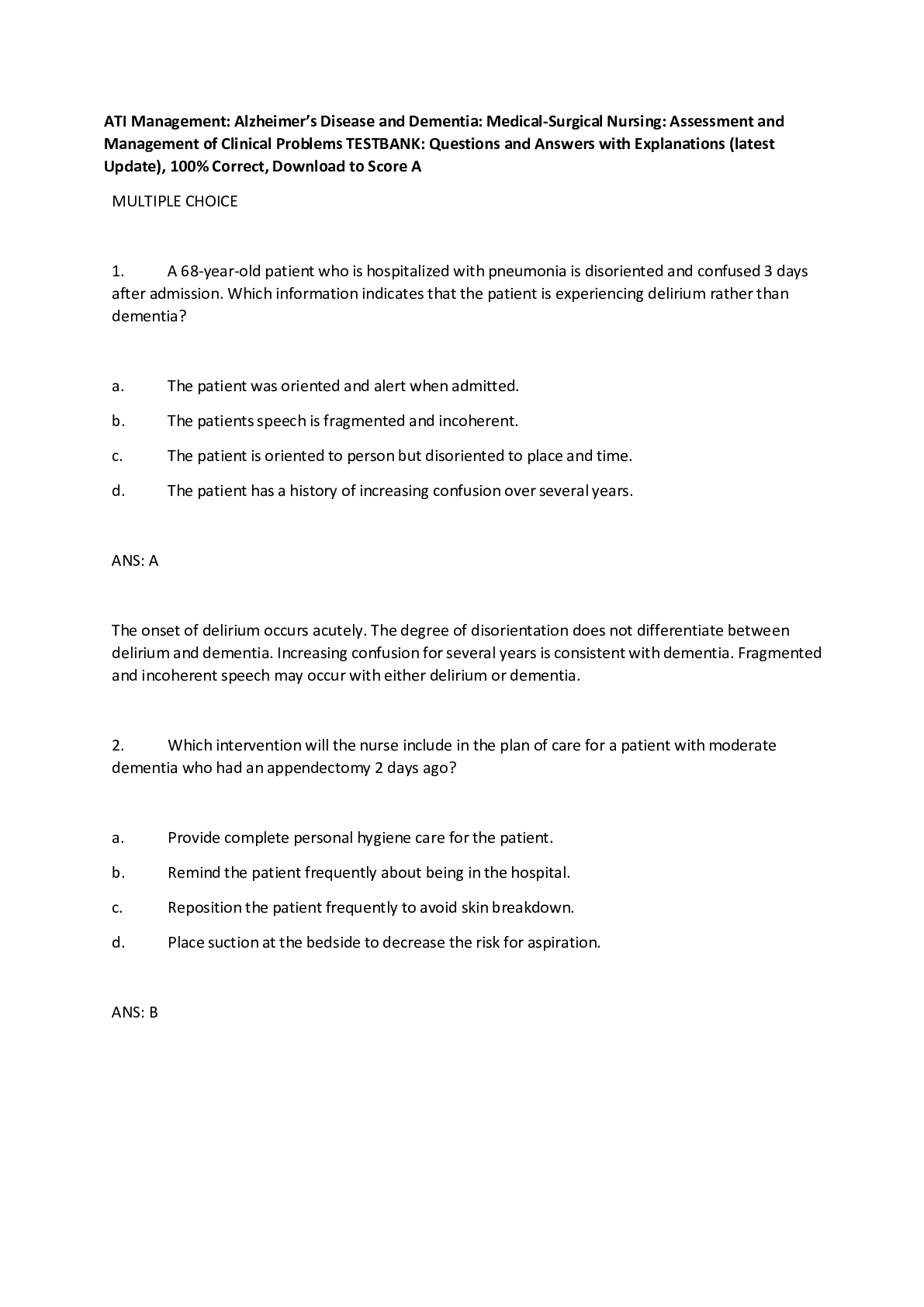

.png)
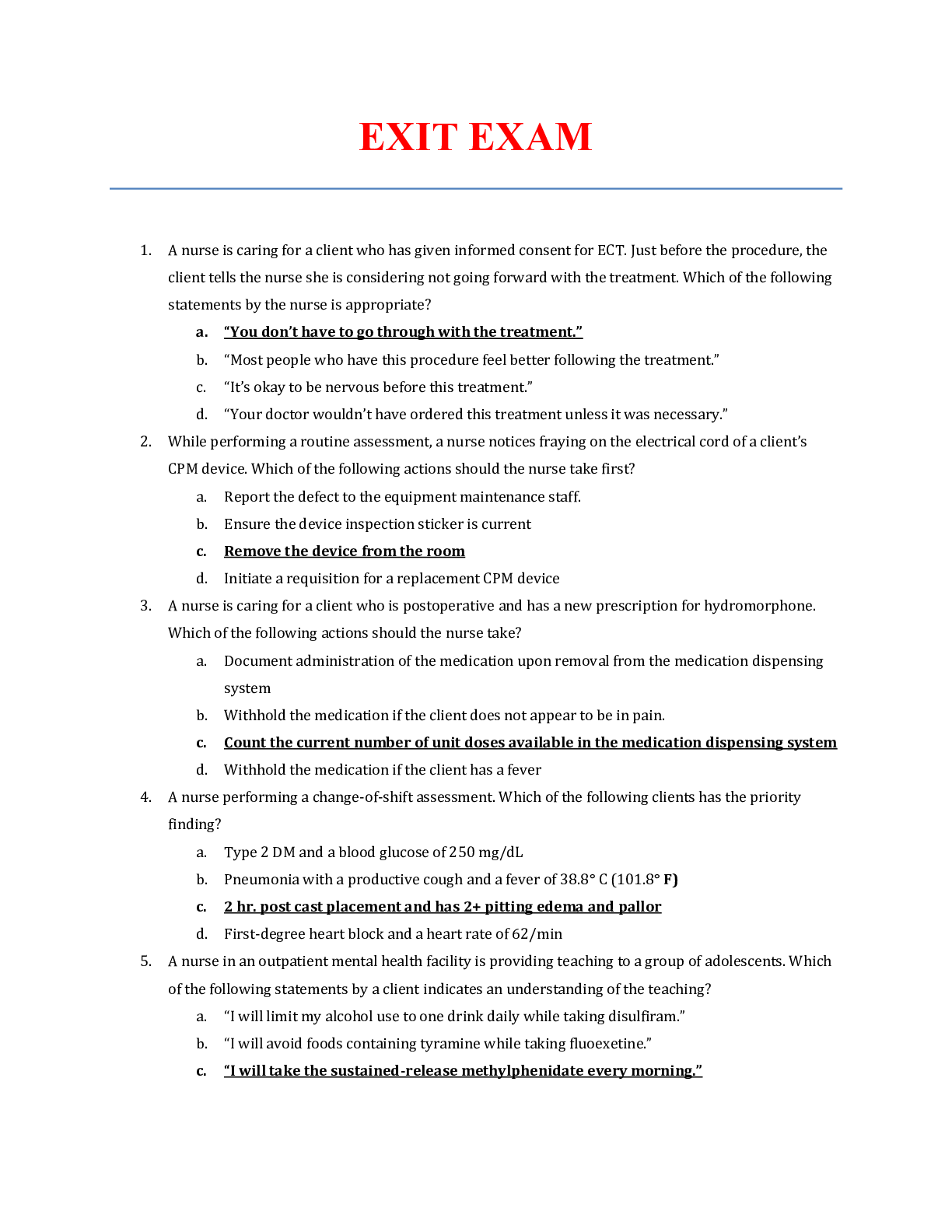
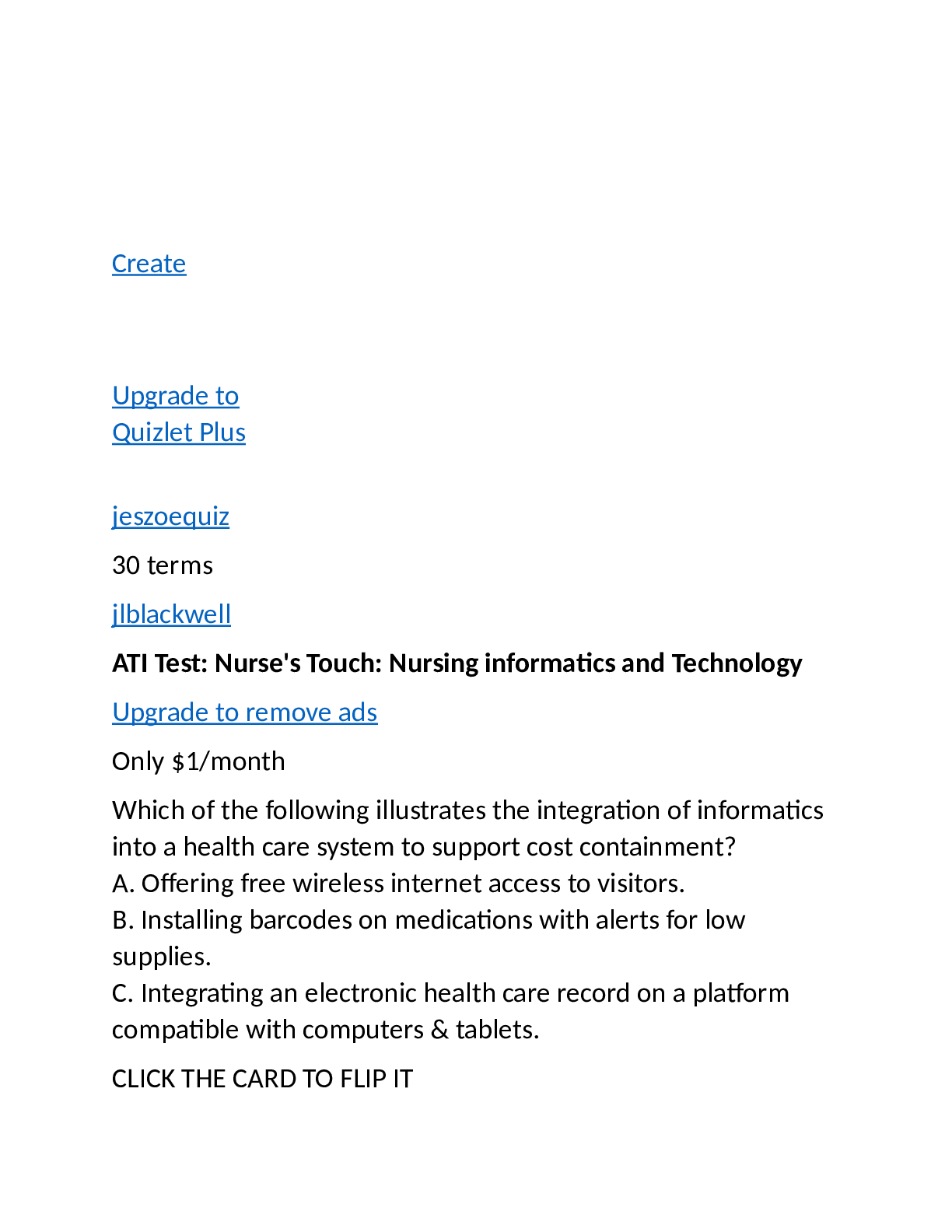
.png)

 Correct Study Guide, Download to Score A.png)
